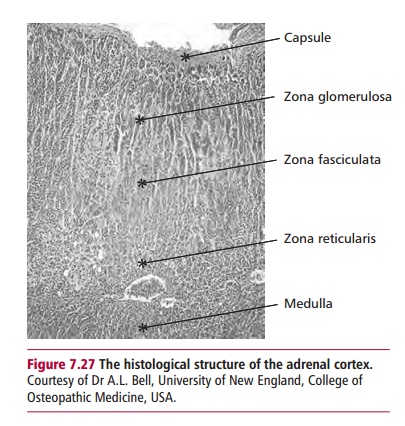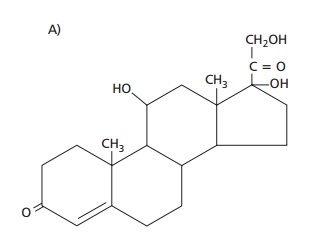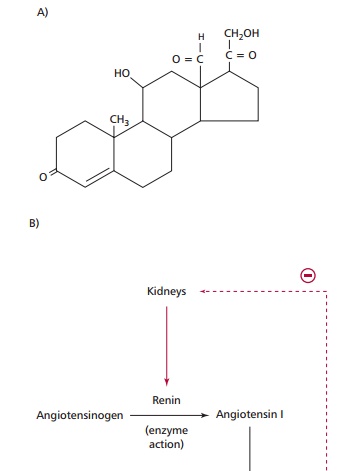Chapter: Biology of Disease: Disorders of the Endocrine System
Disorders of the Adrenal Cortex
DISORDERS OF THE ADRENAL CORTEX
Adrenal glands each weigh about 5 g and are found on
the upper surfaces of the kidneys. They consist of an outer cortex and an inner
medulla. The cortex consists of three layers: the zona glomerulosa, zona
fasciculata and zona reticularis (Figure
7.27). The adrenal cortex is essential for life since it produces three
groups of steroid hormones. The glucocorticoids, such as cortisol, and adrenal
androgens, for example testosterone, are produced by the zona reticularis and
zona fasciculata and mineralocorticoids, such as aldosterone, from the zona
glomerulosa. Adrenal cortex cells have many low density lipoprotein receptors
on their surfaces enabling them to take up precursor cholesterol rapidly from
the plasma.

Cortisol (Figure
7.28 (A)) is released in response to adrenocorticotrophic hormone (ACTH)
from the anterior pituitary that, in turn, is controlled by the release of
corticotrophin releasing factor (CRF) from the hypothalamus. Cortisol exerts a
negative feedback effect on the anterior pituitary and hypothalamus (Figure 7.28 (B)). The secretion of
cortisol shows a diurnal variation: highest in the morning, lowest at night.
Cortisol stimulates an increase in protein catabolism, hepatic glycogenolysis
and gluconeogenesis and a redistribution of adipose tissue but suppresses
inflammation. About 90% of blood cortisol is bound to a cortisol binding
globulin called transcortin whilst the remaining 10% is free.


The major mineralocorticoid, aldosterone (Figure 7.29 (A)), is released in
response to hypotension, Na+ depletion or
hyperkalemia . A group of cells in the kidneys called juxtaglomerular cells
detect a fall in blood pressure and secrete renin which circulates in the blood
and catalyzes the conversion of the plasma protein angiotensinogen to
angiotensin I. A converting enzyme in the lungs converts angiotensin I to
angiotensin II that stimulates the release of aldosterone from the adrenal
cortex and ADH from the posterior pituitary (Figure 7.29 (B)). Aldosterone stimulates the retention of Na+ in exchange
for K+ and H+ in the kidney
tubules increasing the osmolality of the ECF and the retention of water raising
the blood pressure or the ECF volume back to


physiological values. Angiotensin II also stimulates
thirst that helps to increase blood pressure. The adrenal cortex secretes
androgens, such as testosterone, dehydroepiandrosterone sulfate (DHEAS) and
androstenedione. Testosterone is the hormone that stimulates the growth and
development of the male characteristics.
Related Topics